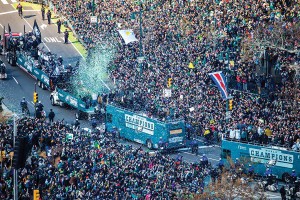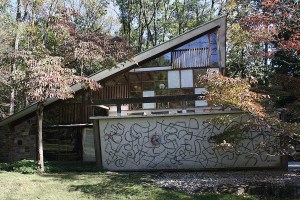How a Vicious Legal Battle Over a Wildflower Farm Tore This Bucolic Philly Suburb Apart
The unbelievable tale of how one Chester County couple's dream of selling peonies on their sprawling Willistown estate devolved into an epic feud between neighbors over who gets to live in paradise — and how.
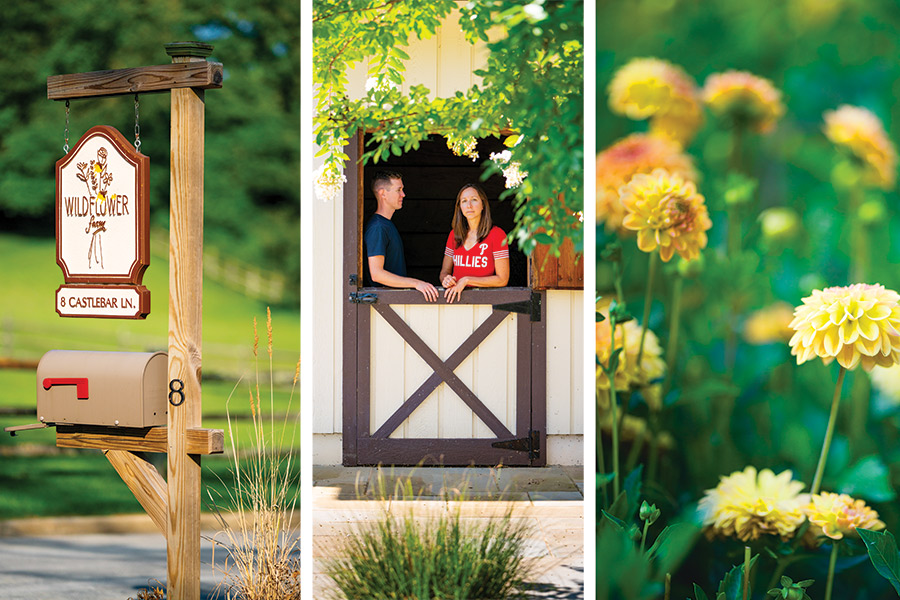
Ryan and Lori Heenan at Wildflower Farm / Photography by Chris Baker Evens
This much, at least, was not in dispute: The man wasn’t happy.
On May 9, 2021 — Mother’s Day, as it happened — Bret Steidle, a tall, middle-aged gentleman with reddish-brown hair, was walking around his neighbors’ property on Castlebar Lane in Willistown Township, a lovely rural community that’s the very picture of Chester County horse country. (Radnor Hunt, the blue-blood-infused fox hunting club founded in 1883, is just down the road.) Wearing jeans, a brown vest, and a black-and-blue COVID mask that read “Support Our Police,” Steidle was pacing around and occasionally taking pictures with his phone.
“This is wrong,” he said finally. Then he raised his voice and gestured in the direction of his own property, several hundred yards away. “This is my home!”
The person Steidle was talking to was his neighbor, Ryan Heenan. Though Heenan, 30 at the time, was hardly the only one standing on the grounds of 8 Castlebar Lane — and this was the crux of the problem.
This particular day marked the opening to the public of what Heenan and his wife, Lori, had dubbed Wildflower Farm, a boutique agricultural venture they’d launched on their eight-acre spread in Willistown. Wanting to celebrate the occasion in style — and well aware that the flowers they’d grown on their property weren’t going to sell themselves — the Heenans had advertised the opening and turned the day into something of an event. They’d brought in a pizza truck to serve free food. They were offering complimentary mimosas and Bloody Marys. They had planters and other gifts for sale. They hired a photographer to take pictures of guests alongside their custom-designed flower truck. And people had come — dozens over the course of the day.

Wildflower Farm
But the presence of all these visitors — not to mention their cars, some parked on the Heenans’ property, others along the street — was not sitting well with Steidle and several other neighbors on Castlebar Lane, a quiet cul-de-sac with seven homes on it. Steidle, in fact, had briefly blocked the entrance to the Heenans’ driveway with his Mercedes SUV.
But now, as Steidle continued to snap pictures of what was going on, Ryan Heenan — who had his phone out recording this entire encounter — was also getting agitated. “I’m asking you politely to leave the property,” Heenan said several times.
“I thought it was public,” Steidle replied, to which Heenan fired back: “It’s not public to you. … You’re harassing us.”
In truth, each man seemed to have a valid argument. While their houses fall within a section of Willistown that’s zoned “rural,” where the minimum lot size is a stately four acres, Castlebar Lane nonetheless has a slightly suburban feel to it. This many intruders descending on the street was certainly not the norm. On the other hand, that same zoning code explicitly stated that farming was allowed in rural districts, as was the sale of farm products — as long as at least 50 percent of what was sold was grown on the property.
This last fact, as the arguing continued, was what Willistown zoning officer Bob Smiley was trying to explain to Steidle. Several weeks earlier, at Ryan Heenan’s request, Smiley had actually issued a zoning opinion spelling out what the Heenans were allowed to do on their property. Smiley was on hand today, also at Ryan Heenan’s request, in case any issues arose. Which, obviously, they had.
“All this is permitted?” Steidle asked, referring to the cars and the pizza truck and the photographer and the mimosas. Smiley explained that it was.
Steidle nodded calmly, and then, after another sharp exchange with Ryan and Lori Heenan, he pointed his finger. “Let me just tell you one thing,” he said, beginning to stride back up the long driveway, back out to Castlebar Lane. “This is just the beginning.”
And so it was.
The residents of Castlebar Lane are not, it’s safe to say, the only people in Willistown Township who like having a little space. Indeed, over the past several decades few places in southeastern Pennsylvania have been as effective at safeguarding open land, and generally holding on to a cool gentleman-farmer vibe, as Willistown has. Nearly two-thirds of the township — which sits about 15 miles west of Philadelphia, about five miles from West Chester — is classified as rural, a zoning decision that feels exactly right when you drive through it. There are rolling hills and grassy meadows and gorgeous farmland, with the occasional lovely home popping up here and there. Once upon a time most of Chester County looked this way, but housing developments and shopping centers and office parks and other markers of modern life have intruded in many places, including neighboring communities like Newtown Square and Easttown Township.
For most of the people who live in Willistown — probably for most people, period — the preservation of such unspoiled land is an unqualified good, for all the reasons we love unspoiled land: its beauty, its wildlife, its environmental importance, its health benefits, its connections to our heritage.
But lately there are questions about whether the people of Willistown, in protecting all this turf, are truly looking out for the common good — or simply trying to hang on to their own little slice of paradise without letting too many other people in. It’s an issue that’s become particularly acute as we battle a crisis around housing availability and affordability. According to housing advocacy group Up for Growth, the Philadelphia metro region is about 80,000 housing units shy of what it needs — a shortage that’s driven up the cost of homes and put them out of reach for some first-time buyers. Since 2020, housing prices are up 47 percent across the country, with Chester County — where the median sale price in the first quarter of this year was $517,000 — the single most expensive market in Pennsylvania. In such an environment, is making so much land off-limits truly the right choice?
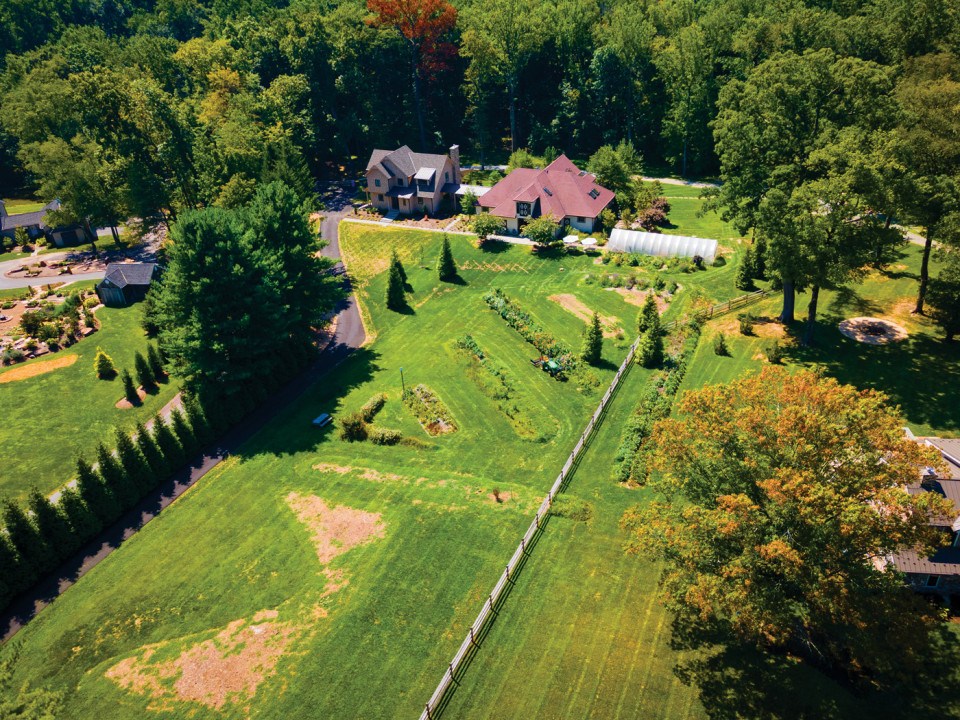
An aerial view of the Heenans’ property, Wildflower Farm
Willistown — and, as we’ll see, the events surrounding Castlebar Lane — makes for a particularly rich case study of all this. I should clarify that by “rich” I mean not just meaty and interesting, but also that this story involves some fairly well-off people fighting with other fairly well-off people. Over the last few years Willistown has become a place where skirmishes abound. Township meetings that used to take minutes now take hours, as neighbors gripe about one thing or another. Residents are currently inflamed about the prospect of a Main Line developer trying to build a bunch of McMansions on what was farmland. Oh, and a few years back there was all the litigation about … a crowing rooster.
It’s a township, and a tale, that features no shortage of fascinating characters, from a farmer and elected official who moonlights as a horror-movie maker to an actual moviemaker — Willistown resident M. Night Shyamalan — who moonlights as a farmer. And then there’s the retiree who’s got the instincts of a seasoned gumshoe. At the heart of all of it is an issue as old as the ages: land, and who gets to control it.
Willistown’s citizenry takes deep pride in the back-to-nature ethos of their community and the culture of conservation that’s long been present here. “We need to start protecting the land because if we don’t, we’re in trouble,” Missy Schwartz is saying as she drives me around Willistown one recent afternoon. “I think we’re already in trouble, personally. Somebody has to make sure that we don’t kill this Earth.”
Schwartz, an energetic, chatty woman with curly blond hair, grew up in Willistown in the 1960s and ’70s. Today she makes her living as a real estate agent, but she proudly clings to her earthier side. She keeps any number of farm animals on the property where she lives, and she’s showing me around Willistown in her Ford F-150 pickup, pointing out all sorts of beautiful natural spots. Willistown is populated by a mixture of old-money families, the nouveau riche, affluent professionals, and some middle-class folks, and Schwartz shows me much of the township, finishing up at Radnor Hunt. She pulls in at the back entrance to the club, pointing out some adorable foxhound puppies in a kennel.
Schwartz loves Willistown, but certainly not more than Bob Lange does. A fit and rangy 69-year-old who stands six feet, six inches tall, Lange co-owns and actively works a 230-acre farm that’s been in his family since 1896. When we meet one morning at Sugartown Strawberries, a farmstand on the property, Lange — known to most people around here as Farmer Bob — shakes his head about how godawful hot it’s been.
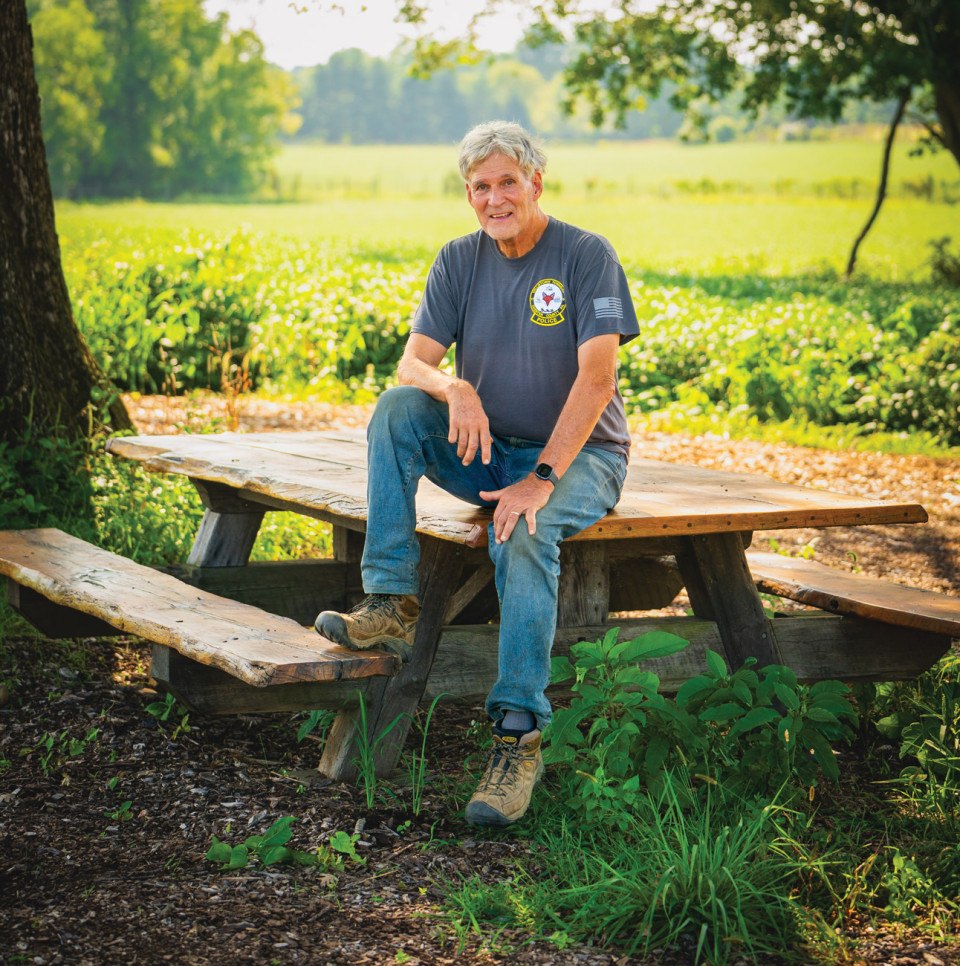
Bob Lange, a.k.a. Farmer Bob, a.k.a. Supervisor Bob, a.k.a. Filmmaker Bob, on his farm
“I was just talking to this fella who’s in his third year of farming — he’s in his early 30s,” Farmer Bob tells me. “He said in his three years, this is the worst. I said, ‘Well, in my 35 years, this is the worst.’ The heat is unrelenting.”
Cultivator of crops is just one hat Farmer Bob wears in Willistown. He’s also Supervisor Bob, having been first elected to the township’s three-person governing body, the Board of Supervisors, in 1996; he’s served more or less continuously ever since. (He took two years off, he says, because he didn’t like one of his fellow supervisors.) It’s a job that pays all of $2,500 per year, and he and his fellow supervisors — one of whom is Lange’s brother-in-law and farm partner, Bill Shoemaker — have traditionally donated the money back to the township. Bob says he tries to keep supervisor meetings, which are open to the community, light and friendly. On the night I attended a meeting this summer, he was wearing shorts and a Hawaiian shirt.
Recently, Farmer Bob/Supervisor Bob has cultivated a third persona for himself — Filmmaker Bob. In 2021 he co-wrote and produced a horror feature called Hayride to Hell that was shot right on his farm. Starring veteran horror flick actor Bill Moseley (perhaps you saw him in 1986’s Texas Chainsaw Massacre 2), the movie is about a fed-up farmer who goes on a killing spree, campily offing a series of people who’ve done him wrong over the years, from a no-good sheriff and corrupt politicians to thieving employees and nosy neighbors. Farmer Bob says his goal with the film — which had a limited theatrical run and began streaming in September — was to create an endowment for the farm, while also highlighting the challenges facing farmers. At movie’s end, our slasher/hero sells his victims’ body parts on the black market and uses the money to save the family farm.
When our conversation turns to Willistown, Bob shares that it was actually his grandmother, Jane Gordon Fletcher, who helped kick off the conservation movement in the township more than 60 years ago when she donated 45 acres of family property to the Natural Lands Trust, ensuring that the acreage would never be developed.

Jane Gordon Fletcher was prescient about what was coming. Beginning in earnest in the 1960s — and basically accelerating ever since — Chester County, like other exurban places across the country, has seen widespread development overtake what had been woods and farmland. The growth has been driven by a variety of factors, including transportation improvements (construction of the Route 202 expressway, connecting West Chester and King of Prussia, began in 1965) and business development (the mammoth Great Valley Corporate Center was built in the 1970s by Willard Rouse). A tsunami of new residents has flooded in.
Protective of its rural identity, Willistown has, through the years, pursued a variety of strategies to keep change at bay. In the early 1960s it adopted its first comprehensive plan, Guidelines for Growth, and ultimately adopted zoning ordinances that mandated relatively large lot sizes in most parts of the township, including that four-acre minimum in the areas zoned “rural.” By the mid-1960s the Pennsylvania Supreme Court would look skeptically at such large minimum tracts, but in part because Willistown was explicit in saying its goal was to cultivate agriculture in those areas, the four-acre minimum has remained.
Township residents have also taken advantage of land-protection programs created by county and state governments, including Pennsylvania’s Act 319, whose goal is to preserve farmland and forests in the commonwealth. Meanwhile, in 1999, Farmer Bob — or, in this case, Supervisor Bob — led the push for the creation of an open space fund in the township. More than 80 percent of Willistown residents voted to increase their own taxes to allow the township to buy undeveloped land as it became available. The township now officially owns more than 290 acres of protected, publicly accessible land.
Of course, the biggest force when it comes to land preservation in Willistown has actually been a nongovernmental entity, the nonprofit Willistown Conservation Trust. The organization’s roots go back to the late 1970s, when local conservationists began working with the Brandywine Conservancy to protect open space in Willistown. In 1996, the WCT was created as a stand-alone organization, with one of those conservationists, Bonnie Van Alen, at the helm and some deep-pocketed township residents on its board.
WCT, whose work covers Willistown and some nearby areas, has engaged in an array of land protection activities ever since, including acquiring the property for and managing five different nature preserves in Willistown, four of which are open to the public. Still, the most effective arrow in its land preservation quiver has been what’s called the conservation easement — a legally binding agreement that essentially allows private landowners to permanently protect their land from development. (Some might choose to prohibit any future construction; others might lay out strict limits.) The property owners maintain title to the land — they’re free to live on it, free to sell it — but once the easement is in place, it’s there forever. Even future owners of the land must abide by the restrictions.
In Willistown, dozens of property owners have stepped forward to take advantage of the easements; WCT boasts that over the last 40 years, 7,500 acres have been protected in greater Willistown. If you’re scoring at home, that’s about 12 square miles — larger than all of South Philadelphia, and nearly three times the size of nearby Ridley Creek State Park.
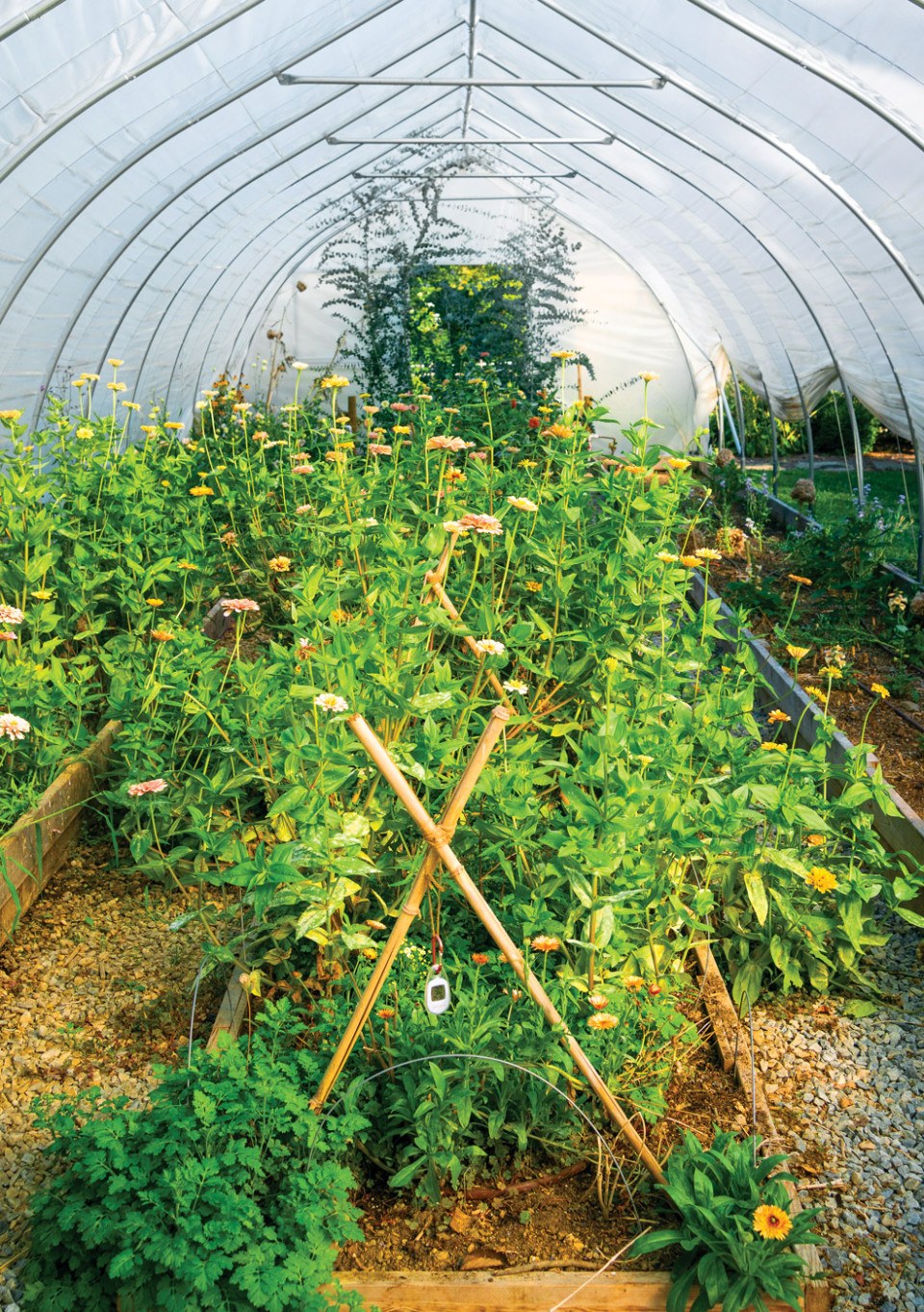
Wildflower Farm
Now, I should point out that all of this hasn’t stopped development completely in Willistown. Occasionally some of the township’s beautiful farmland comes on the market, and, if it’s not under easement, developers have come in to build homes — usually luxury ones.
Most of the people who buy here these days are looking for peace and quiet. But not all of them, it seems, necessarily have the same sense of “rural” that longtimers like Missy Schwartz and Farmer Bob do. In 2008, Schwartz, wearing her real estate agent hat, sold a home across the street from her own house to an architect. All was fine initially, but in 2015 the architect started complaining about a series of roosters Schwartz was keeping on her backyard farm — the cock-a-doodle-dooing was interrupting his sleep. (According to a log introduced in legal proceedings, on one August day in 2019 the rooster crowed 163 times, beginning at 4:29 a.m.) When Schwartz declined to do anything about it — she’d told the architect when she sold him the house that people had backyard farms in Willistown — he took her to court. After much legal wrangling, the case came to trial and the judge made his Solomonic decision, metaphorically splitting the bird in half: Schwartz could keep the rooster, but she was required to put him in the shed at night to keep him quiet. Residents whispered that the whole episode had cost tens of thousands in legal fees.
“If it was up to me, I would take every acre that’s left in Willistown and preserve it,” Farmer/Supervisor/Filmmaker Bob says of development. “Because once it’s gone, it’s gone.”
It was, of course, the abundance of beautiful open land that made Ryan and Lori Heenan want to live in Willistown in the first place. Ryan, who has his own real estate business, had been introduced to the township by his father, Joe, a retired construction company owner who lives on the Main Line but had invested in property in Willistown. Ryan and Lori bought their Castlebar Lane property in 2015; when they got married a year later, none other than Farmer Bob gave them a tractor ride from the church to the barn on the Heenans’ property where they were having their reception.
Initially, the young couple had planned to use that barn, which they spent a significant amount of money restoring, as an event space. But in January 2021, after hosting a handful of events over the previous year or two (including a fundraiser for the Willistown Conservation Trust), they received a zoning notice from the township. They weren’t allowed to rent the facility out.
The Heenans say they weren’t upset by the ruling, since by that point they were transitioning to a different idea anyway: running a small flower farm. Not wanting to incur any more zoning issues, Ryan had officially requested that zoning opinion about the farm from zoning officer Bob Smiley; he issued an opinion that the Heenans read as a green light.
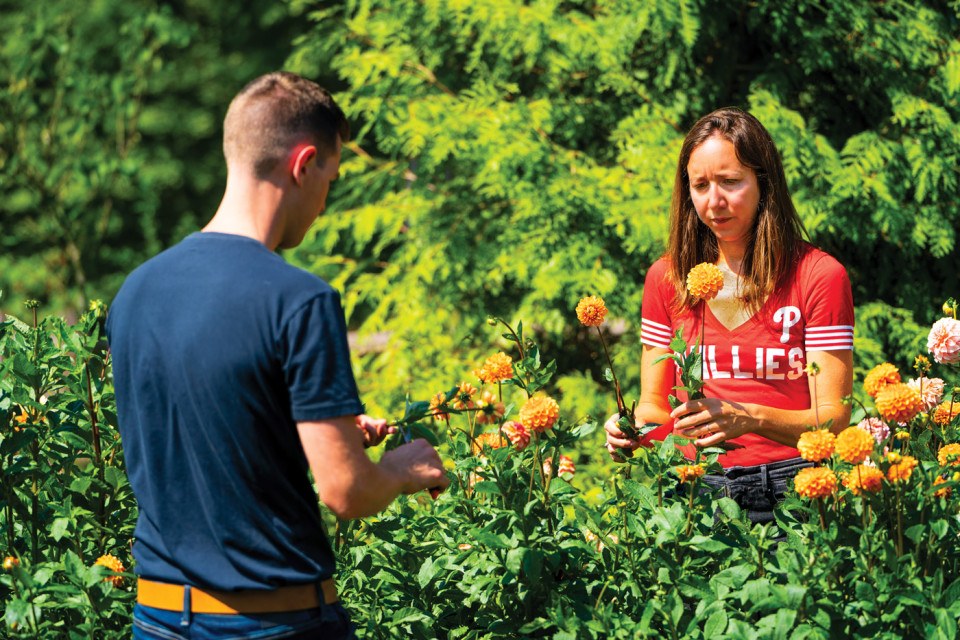
The Heenans at harvest time
Then, alas, came the Mother’s Day blowup with the Castlebar Lane residents. Afterward, hoping to smooth things over, the Heenans sent a letter to their cul-de-sac neighbors (well, everyone except Bret Steidle) suggesting that they all meet to try to work things out. The only response they got was an envelope — just an envelope — addressed to “the Horrible Heenans.” (The neighbors involved in the dispute didn’t reply to emails I sent through their attorneys requesting comment for this story.)
Even worse for the Heenans, shortly after the Mother’s Day event, the couple received three official notices that they’d violated township ordinances. One was a citation for holding an event without a permit. A second cited them for not having followed proper procedures for some of the improvements on their property. The third was about the operation of Wildflower Farm itself. While the notice acknowledged that Willistown’s zoning code allowed them to sell farm products on their property, it also noted that the code stated use of the property “shall not include a business.” With their Mother’s Day event, the Heenans had “exceeded the permissible uses” of their property.
The Heenans were confused. First, hadn’t they gotten a zoning opinion giving them a green light for the Mother’s Day event? Second, the idea that a farm property “shall not include a business” was nonsensical. Wasn’t the selling of farm products itself a business? Indeed, wasn’t that exactly what Farmer Bob was doing when he sold fruits and vegetables at Sugartown Strawberries? What’s more, if the issue was the free food and drink the Heenans gave out, well, that was simply marketing. Hell, Farmer Bob advertised bonfires and birthday parties at his place, and that was never a problem.
The Heenans hired a lawyer and appealed.
It is beyond comprehension why they would invite the public to come and spend time in the country.” — Lonnie Gray, Willistown resident
That summer, the hard feelings among the neighbors only intensified. After the Heenans held a gathering in the barn over the July 4th holiday — they say it was for friends and family — the neighbors fired off emails (eventually obtained by the blog Chester County Ramblings through a right-to-know request) to township officials. They seemed to fear that the Heenans still secretly wanted to have an event space and were using the flower farm as cover.
“Didn’t you put a stop to this?” a neighbor named Michael Wall wrote to township Supervisor Bill Shoemaker (Farmer Bob’s brother-in-law) on July 5th. “You indicated on the phone to me that you had the power to stop this. … Obviously they feel they can operate with no regard to the township or the neighbors.”
In another email, Wall wrote, “Perhaps you don’t understand the plight of neighbors who chose a rural setting and have found themselves in a neighborhood where one neighbor is permitted business, noise, commerce and traffic. Think of all the neighbors.”
Neighbor Lonnie Gray hit a similar theme in an email she sent to the Planning Commission back in May: This kind of thing just wasn’t Willistown. “Keep Willistown intact as it has been for years,” she wrote. “The township is one that is widely admired and held up as a model of open space and conscious conservation. Let’s keep it that way.”
In a later email, Gray offered, “I have no problem with the Heenans growing and selling flowers. … What I fiercely object to is their blatant commercialization of their property, and the ongoing disruption to a small cul-de-sac.”
She added, “It is beyond comprehension why they would invite the public to come and spend time in the country.”
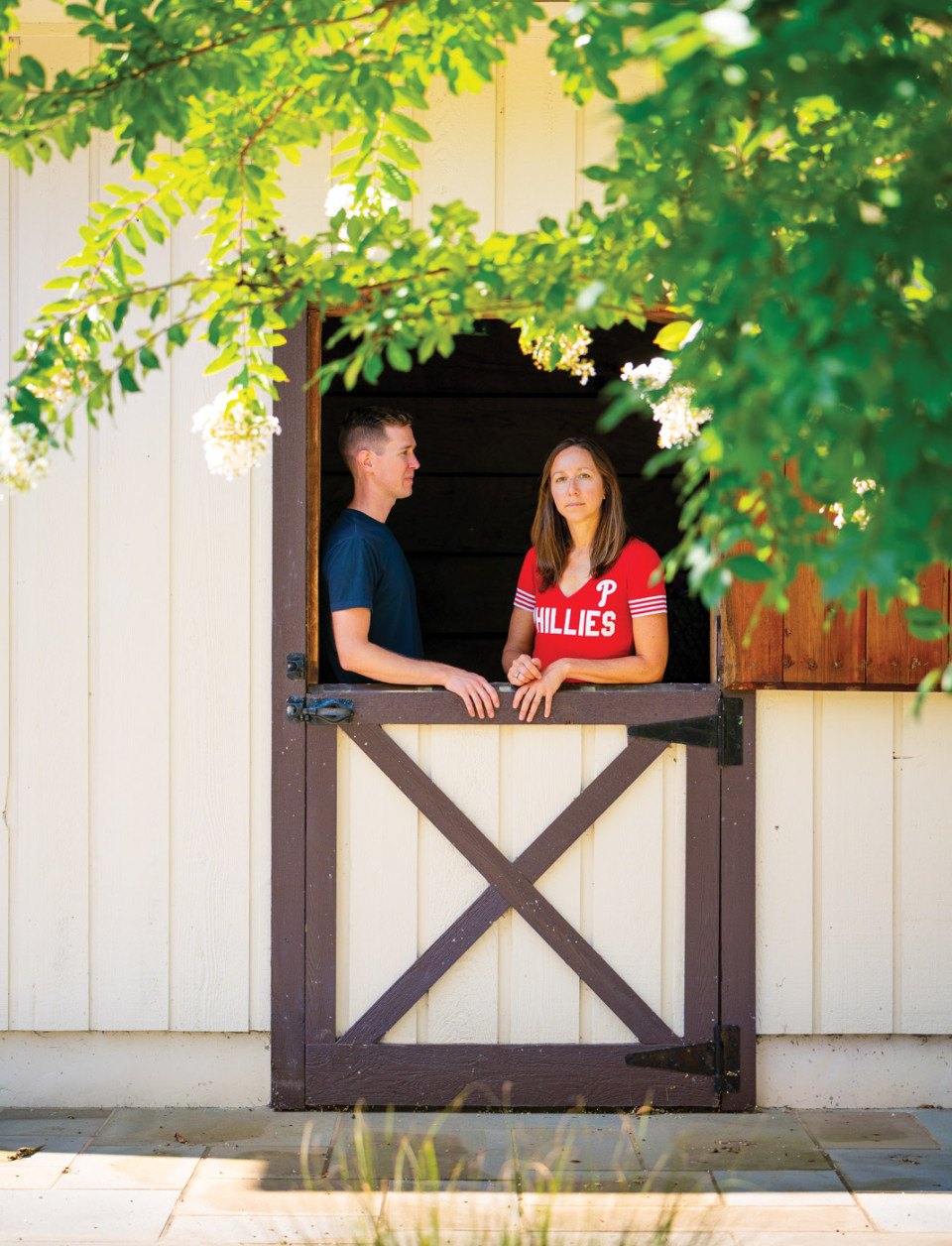
The neighbors, too, lawyered up.
Alas, that fall things didn’t go their way. After an October hearing before the zoning board, a decision went in favor of the Heenans.
Then, in December, the township — perhaps realizing that its own zoning ordinance might be problematic — reached a settlement agreement with the Heenans. The zoning ordinance in question — which said, in essence, you can have a farm but you can’t have a business — was left in place, but the agreement spelled out a very specific set of conditions under which the Heenans could operate. They could engage in farming activities and sell farm products, as long as 50 percent had been grown on the property. They could hold marketing activities like workshops and tours, as long as they didn’t charge for them (only for the flowers). As for the traffic Wildflower Farm might generate, the agreement was very specific: “There shall not be permitted at the Property any more than thirty (30) individual passenger cars, two (2) buses, or three (3) passenger vans.”
Lori Heenan laughs now. “We don’t know where the bus thing came from. We never asked for that.”
Buses on Castlebar Lane, in the middle of secluded Willistown? The neighbors were not going to be happy.
One morning this summer, I hop on a Zoom call with two representatives of the nonprofit that’s been so effective at protecting land in Willistown, the Willistown Conservation Trust. Kate Etherington, who grew up riding horses in neighboring Easttown, became WCT’s executive director in 2021, succeeding founder Bonnie Van Alen (who remains on the board). Erik Hetzel, who got interested in conservation after watching the development of the Great Valley area in the 1970s and 1980s, has been WCT’s director of land protection for a decade.
WCT has grown significantly since its founding nearly three decades ago; it now operates with an annual budget of nearly $3 million. Its website presents it as a progressive organization, with a DEI statement, pronouns listed for each of its staff members, and a land acknowledgment, which notes that the organization’s work takes place on the ancestral land of the Lenni Lenape. “We affirm the aspiration of the great Lenape Chief Tamanend,” the statement says in part, “that there be harmony between the Indigenous people of this land and the descendants of the immigrants to this land, ‘as long as the rivers and creeks flow, and the sun, moon, and stars shine.’”
In our conversation, Etherington and Hetzel are friendly and thoughtful — they acknowledge how complex issues around land preservation can be, and they’re certainly not against all development. But they’re deeply passionate about the work that WCT does. “If you look at the world in general, land is disappearing at an alarming rate, habitat is disappearing at an alarming rate,” says Etherington. “We’ve lost three billion birds in the last 50 years.”
But it’s not just about wildlife, she continues; there are compelling human reasons for restricting land use. Land preservation mitigates climate change, she notes. It controls stormwater runoff and prevents flooding. It protects our drinking water. It aids people’s mental and physical well-being. If we’re not smart about what land gets developed? Etherington uses the same phrase Farmer Bob does. “Once it’s gone, it’s gone,” she says.
In addition to the South Philly-sized area WCT has already helped conserve, the organization has a stated goal — “aspirational,” Hetzel says — of protecting an additional 4,000 acres in Willistown and nearby areas. That number isn’t random, nor are the properties the organization works with landowners to put under easement. WCT’s strategy is to collect green spaces that are connected and contiguous, thereby protecting habitats and maximizing the conservation impact.
The benefits of effective land preservation are, in so many respects, impossible to argue against. Who wants lousy drinking water? Who’d prefer to be flooded? Who feels good about billions of birds disappearing? Who wants more miserably hot summers brought on by climate change?
All that said, it’s fair to question whether Willistown’s collective approach to land protection is really meant to benefit everyone — or just a few.
For instance, for decades critics have said large minimum lot size requirements, like Willistown’s four-acre minimum, are effectively, perhaps intentionally, exclusionary, keeping people out of a community who don’t quite look like the people who’ve long lived there. In Willistown, only about 2 percent of the township’s 11,000 residents are Black, while more than 87 percent are white. Now, such lack of diversity has roots and causes that long predate the conservation movement, but restricting where and how much new housing can be built certainly makes the problem harder to solve. Meanwhile, Willistown is not just whiter than your average community, it’s also wealthier, with a median income 1.5 times higher than the rest of Chester County and more than twice as high as the rest of Pennsylvania. And with the skyrocketing cost of real estate, its status as a haven for the well-off is only intensifying.
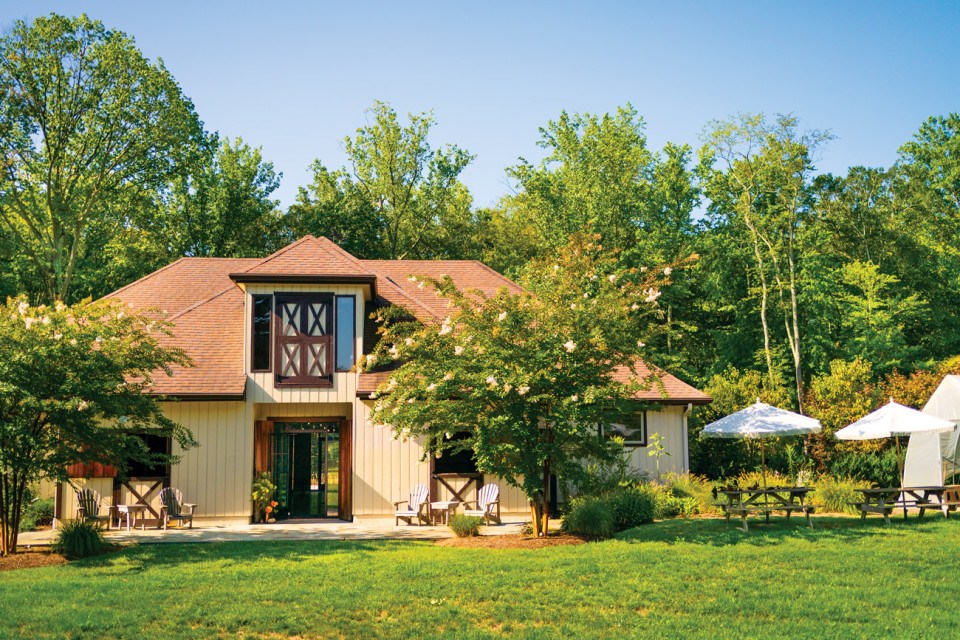
“I don’t know that I could afford to buy the house that I live in today,” says Hetzel, who bought a home 20 years ago in what he and others jokingly call the “poor” part of Willistown, the more densely constructed north end of the township. Etherington says that Willistown in general has gotten so expensive that most of WCT’s staff — the people who spend their days protecting open space in the township — can’t actually afford to live there.
Speaking of economics: There’s also the question of whether some land preservation programs, which use tax breaks to incentivize people not to develop open land, offer an outsized benefit to people who are well-off.
Property owners who opt for a conservation easement, for example, can potentially get a significant deduction on their federal income taxes — one equal to the difference between the value of the land if it could be developed and the value of the land with future development restricted. If, according to an independent appraisal, a piece of property has a value of $1 million without a conservation easement but just $500,000 with the easement, then the property owner is eligible for a $500,000 deduction on federal income taxes. (There are limits on how much of the deduction can be taken in one year, but a property owner can spread it out over several years.) What’s more, by technically lowering the value of the land, the property owner also saves on federal estate taxes when the land is passed on to the next generation.
In some ways this seems fair: Not only are property owners voluntarily lowering the value of their land, but for them to get the deduction, the IRS insists that they satisfy one of four different conditions, one of which is that the land under easement is accessible to the public. This is, in other words, a transaction taking place for the common good. “We try to make sure there’s public access in each one of those easements, because that’s one of the things the IRS looks at closely,” says Hetzel.
The question is, does the public actually know about all that public access? In contrast to, say, Ridley Creek State Park, which is well marked on maps and well publicized, there is no map detailing public access to all that Willistown land that’s under conservation easement. “We openly publish and blaze trails on our public preserves,” Etherington says, “but typically not on private lands without landowner consent in an effort to balance public access with landowner privacy.” She notes that easement information is available through the Chester County Recorder of Deeds — not exactly the easiest source to access if you’re looking for a weekend hike.
Another land protection program that’s prevalent in Willistown, Act 319, also uses tax breaks to accomplish its ends, in this case a reduction in local property taxes every year for landowners who sign up for the program (to qualify, you must have either 10 acres or $2,000 per year in agriculture sales). Certainly for family farmers this seems reasonable; Farmer Bob (who’s enrolled in the program) explains to me that, without that break, many farmers would be forced to sell off pieces of their property every year to cover the high property taxes.
But not everyone who benefits from Act 319 has as large an operation as Farmer Bob does. The Heenans, with their boutique farm, have taken advantage of it, as has their neighbor Michael Wall. Wall and his wife, Tana, co-own two undeveloped lots on Castlebar Lane, on which, according to Realtor.com, the property taxes are just $126 per year. In contrast, one typical house I saw in the “poor” north end of Willistown — a three-bedroom home on two-tenths of an acre — comes with an annual tax bill of $3,400. (That’s one reason north end residents have for years complained that they’re effectively subsidizing the people with beautiful pieces of property in the southern end.)
Finally, there’s the question of whether Willistown is using the public coffers less to benefit everyone and more for people who are already doing well. In 2022 a gorgeous property in Willistown — the 210-acre Kirkwood Farm, owned by descendants of the Rockefeller family — went on the market. The land had long been on WCT’s wish list for protection, and with good reason: It’s ecologically significant, and it provides stunning views in the rural part of the township. Fortunately for WCT, a conservation-minded buyer — none other than M. Night Shyamalan, who already owns a 100-plus-acre farm abutting Kirkwood Farm — expressed interest in the property. A deal was struck: Shyamalan would buy the property for $24 million and sell 90 acres of it to WCT, which would turn it into a nature preserve.
The only wrinkle? A chunk of the $9 million cost for the 90 acres came from taxpayers. Willistown Township kicked in $3 million from its open space fund, while Chester County added $750,000. In addition, WCT applied for a $4.5 million state grant to help cover the cost. It didn’t receive funding last year, but it’s reapplied this year for a lesser amount. If the money does come through, taxpayers outside of Willistown — a nurse in West Chester, a firefighter in Scranton — will be kicking in to purchase property in the most expensive real estate market in the state.
Again, in fairness, the new preserve will be open to the public. When I ask Etherington how many people visit WCT’s four other publicly accessible preserves, she says it’s tough to tally, but her staff estimates it’s about 7,800 people per year.
Is that worth it? Indeed, is the public outlay of resources worth it for all the land in Willistown that’s been protected? If the measure is public access, the answer is pretty clearly no. Ridley Creek State Park, for example — just a third the acreage of what’s been preserved in Willistown — has averaged more than 950,000 annual visitors for the last decade.
For the Heenans and Willistown officials, the settlement agreement they signed in December 2021 felt like a final resolution to the dispute. The Heenans could operate Wildflower Farm; the township would keep its zoning ordinance, including the “shall not include a business” language; and all would be well in Willistown.
Except the Castlebar Lane neighbors didn’t see it that way. In early January, just weeks after the settlement agreement was signed, attorneys for the neighbors went to court to challenge it. Among the arguments was that the agreement amounted to “contract zoning” — that is, that the township was willfully ignoring its own ordinance and creating a side deal that would let the Heenans operate their farm, potentially bringing all those outsiders to Castlebar Lane. The township, the neighbors were arguing, was simply not allowed to do that.
From a legal perspective, it seemed to be a strong case. The zoning ordinance clearly stated that while you could sell farm products, you couldn’t operate a business on land in the rural area of Willistown. And yet the Heenans were plainly, proudly, defiantly doing just that. What’s more, the settlement agreement allowed the Heenans to do all sorts of things — tours, workshops, demonstrations — that weren’t even mentioned in the zoning ordinance.
The Heenans got it. The township might have created this wink-wink-nudge-nudge deal with them, but if the neighbors could get it tossed out in court, what good was it? Which is why, in February 2022, they decided to up the ante further. They filed legal pleadings arguing two things: first, that Willistown’s zoning code was actually in direct violation of Pennsylvania law, which explicitly bars local municipalities from enacting ordinances that prohibit or limit “normal agricultural operation.” They said the zoning code did that in a variety of ways; thus, it was unlawful.
But the Heenans didn’t stop there. They also argued that Willistown’s long-standing four-acre minimum lot size was illegal. The township had always justified it by saying it wanted to encourage agriculture in Willistown, but since Willistown’s own zoning code did things to discourage agriculture, that rationale, they said, was specious. Hence, the four-acre minimum was illegal.
The Heenans were essentially presenting the township with an ultimatum: Either change the zoning ordinance and let them operate their flower farm without any interference — or keep the zoning ordinance but toss out the four-acre minimum lot requirement. Oh, and if the township chose the latter path? Then the Heenans would officially request to subdivide their eight acres of land into one-acre parcels. Wouldn’t eight brand-new McMansions look lovely on Castlebar Lane?

Lori Heenan arranges flowers in Wildflower Farm’s barn.
The legal challenge, not surprisingly, got people in Willistown buzzing. No longer was this a simple dispute among neighbors. Now it was an attack on how Willistown had functioned — how it had protected its land and itself — for some 60 years.
The Heenans say people began reaching out to them, asking if the challenge to the four-acre lot minimum was really necessary, wondering if what they were doing wasn’t just a little bit … drastic. They also say they heard from a township official, who told them Willistown always figured the four-acre minimum would be challenged one day, just not like this.
“We always thought it would be Toll Brothers,” the official said. “Not someone living here.”
In 1980, the population of the United States was 226 million people, and the population of the Philadelphia metro region was 4.5 million. Today, the U.S. has grown to 336 million people, the Philly metro area to 5.8 million. In those same four-plus decades, Chester County has also seen fast growth, with its population rising from 316,000 residents to 550,000.
Suburban sprawl is often framed in a “developers gone wild” kind of way — greedy real estate honchos and builders bulldozing paradise in pursuit of a fast buck. That’s not necessarily incorrect; developers certainly do want to make money, and some of them might not care a whit about preserving nature. But ultimately that’s not what the disappearance of open land is all about. It’s mostly about a growing population and the need for all those additional people to live, work, shop, eat, and play somewhere.
Growing population also underlies our current housing crisis. For a long time we did pretty well when it came to building new homes for all those additional bodies, but over the last 15 years things have stalled, particularly when it comes to more moderately priced starter homes in demand by millennials and Gen Zers. There’s a variety of reasons for that — from the Great Recession to private equity buying houses as investment properties. But limits on property use — including suburbs that discourage multifamily housing and impose minimum lot size requirements — have played a significant role.
“Government regulation, including zoning, has increased the cost of real estate, which has decreased the supply,” says Pennsylvania State Senator Greg Rothman, a Republican who represents a district that includes part of Harrisburg. Rothman has spent his career working in real estate, and so he obviously brings a particular point of view to the issue. But many property restrictions, he believes, “are exclusionary, and I believe they’ve had an adverse effect on people being able to own homes, which is the American dream.”
That’s pretty lofty talk, although at the heart of the issue, I’d argue, is actually a pretty simple question: How much freedom should a community have to determine what it wants to be? If a place like Willistown decides it wants to reject development and preserve its rural character, is that okay?
As it happens, that was the issue Pennsylvania’s Supreme Court took up nearly 60 years ago in a case involving, ironically, Willistown’s Chester County neighbor, Easttown Township. At the time Easttown, too, was fearful of the steady march of development coming its way, and so, like Willis-town, it adopted a four-acre minimum lot size in portions of the township. But a developer challenged the restriction, saying the township didn’t have a right to do that.
The state Supreme Court — in a decision that still holds sway in Pennsylvania — agreed. The court, which called the four-acre minimum “exclusive and exclusionary,” cited a variety of reasons for striking down Easttown’s ordinance, including the fact that a municipality can’t just ignore what’s happening in the world around it. “The question posed is whether the township can stand in the way of the natural forces which send our growing population into hitherto undeveloped areas in search of a comfortable place to live,” the court said. “We have concluded not.” It also said, “Zoning is a means by which a governmental body can plan for the future — it may not be used as a means to deny the future.”
In many ways, that’s what Willistown has been trying to do — perhaps for noble public reasons, perhaps for less noble private ones — for decades now. It wants the township to remain as it was in 1960, even though 1960 was a very different time.
So, back to the housing crisis: Along with colleagues on both sides of the aisle, Rothman has put together legislation that would limit the restrictions municipalities can adopt when it comes to development. For example, the bill would allow duplexes to be built in areas zoned for single-family housing and restrict minimum lot sizes. Rothman believes it will take a couple of legislative sessions for the bill to get traction, but he’s confident that, because the issue has support from conservatives like himself as well as progressives like Philadelphia State Senator Nikil Saval, some version of it will eventually become law.
How this might affect a place like Willistown is tough to say. When I ask Rothman about issues like open space preservation, he says he has no interest in paving over paradise. At the same time, he notes that Pennsylvania has no shortage of unspoiled land. According to government statistics, forests cover 57 percent of the state, while farms cover 26 percent.
Rothman points out another irony as well: In many cases the restrictive zoning that municipalities adopt comes about because people move to a place, fall in love with it, and don’t want it to change. “I’ve dealt with NIMBYism my whole career,” he says. “You get your paradise, and then you say, I don’t want anyone to build next door to me. Well, that has an effect.”
His comment makes me think about Willistown. The houses along Castlebar Lane don’t date back to the late 1800s, like Bob Lange’s family farm does. On the contrary: None of them was built until at least the 1980s, when land owned by a member of the du Pont family was divided into smaller parcels.
Put another way: Are the people who live on Castlebar Lane — who want to “keep Willistown intact as it has been for years” — precisely the kinds of people Farmer Bob’s grandmother didn’t want moving into Willistown in the first place?
And then, suddenly, there was peace.
Potentially faced with a choice between scrapping its zoning ordinance and abandoning its four-acre minimum lot size requirement, Willistown officials decided it was worth sitting down with the Heenans again to see what they could work out.
As for the Castlebar Lane neighbors, the path to a resolution was a little trickier.
Following the Heenans’ legal challenge in February, a local website ran a story about the controversy, in which neighbor Lonnie Gray again expressed concern that the Heenans wanted to operate an event venue. Meanwhile, a new website was launched that accused the Heenans of trying to skirt zoning laws. But the grandest gesture came when a postcard was mailed to households throughout the township. It showed a picture of horses — although the Heenans say they never owned any horses — along with images from a brochure the couple had created when they were imagining the barn as an event space. “Would YOU want to live next to a party venue holding events, bus tours, and wine tastings?” the postcard said. “Learn more about the sham of Wildflower Farm — the farm that isn’t.”
When the Heenans saw it, they were furious. It was, in their minds, slanderous. But what could they do? It wasn’t even clear who’d sent the postcard.
Enter Ryan’s father, Joe Heenan. In recent years he’d become something of a gadfly in Willistown, showing up at most township supervisor meetings and asking pointed, detailed questions about various things the board was doing. Throughout the saga with the neighbors, he’d been advising and supporting Ryan and Lori.
And now he had an idea. The postcard mailed out to township residents was postmarked in Conshohocken, which likely meant, Joe thought, that it was also printed there. He arrived one day at a print shop in Conshy and said he was looking to mass mail a postcard. Did the shop happen to have any samples? The salesperson came back a moment later with the mailer that had been sent to everyone in Willistown. Bingo.
The Heenans’ lawyers sent a letter to the print shop, asking them not to destroy any records — the Heenans were considering a defamation suit. Almost immediately, the lawyers got a phone call from one of the attorneys representing the neighbors. It was clearly time to negotiate.
Over the next couple of months an agreement was hashed out among all the parties. The Heenans agreed to drop their legal challenge to the four-acre minimum and the township agreed to update its zoning ordinance, changing the language about operating a business and specifically detailing that property owners running farms had the right to sell — and market — their products. As for the neighbors, the Heenans agreed not to go forward with a defamation suit against them, while the neighbors dropped all of their legal challenges involving the Heenans.
The Battle of Castlebar Lane was over. Hundred of thousands of dollars had been spent in legal fees.
Still unresolved are the larger issues the story of Willistown brings up. How much open space can the township preserve, and what are the best ways to do it? Is this all just a way for a few people to live in their own private paradise?
Lately, a battle has broken out in Willistown over a new project proposed by Main Line real estate developer J. Brian O’Neill. A few years ago, O’Neill purchased — for $25 million — a glorious, 247-acre Willistown property called Rock Hill Farm. Initially, residents were hearing that O’Neill was planning to build a family compound on the property. But then he revealed something different: a new development that could contain 20 brand-new luxury houses.
Almost no one disputes that O’Neill has the right to build his development. But that hasn’t stopped outraged Willistown residents from creating a website opposing the project and putting up “Save Rock Hill Farm” signs all over the township. Is their fight about land preservation? NIMBYism? Both?
In many ways O’Neill’s plan for luxury housing seems to be about the worst option possible. If the project moves forward, dozens of acres of beautiful farmland will disappear forever, but only a few people will be able to live there. In a region that’s 80,000 housing units short of what it needs, that’s not making much of a dent.
Is there a better solution? Ryan Heenan offers one. Willistown’s large minimum lot sizes typically lead to large houses. Indeed, in areas of the township with a four-acre minimum, the zoning code allows for 10 percent coverage for the footprint of whatever home you build. But rather than one giant house on that footprint, why not build several smaller ones? As Heenan puts it, “Why can I not construct five small two- or three-bedroom cottages clustered around a central green in the same building footprint?” It’s an appealing solution: the same amount of open space preserved, but with more — and more moderately priced — housing. Of course, doing this would require a zoning change. Sigh.
Whatever happens next in Willistown, Bob Lange told me he’s had enough of politics. He’s frustrated by developers wanting to build even more in Willistown — “How much is enough?” he asks — and he’s had it with all the fighting that’s gone on. Once upon a time he enjoyed being a supervisor. No more. Civility has disappeared.
So Supervisor Bob could disappear. But Farmer/Filmmaker Bob will have plenty of things to keep him busy. He’s already started working on the script for a sequel to Hayride to Hell. And he has his farm to run — the one that’s been in his family for 128 years, on land that William Penn himself had been granted by King Charles II, that for thousands of years before that was home to the Lenni Lenape.
It’s funny, but despite that earnest land acknowledgment from the WCT, not one person I spoke to in Willistown suggested giving it back to them.
Published as “Hell Is Living Next to a Wildflower Farm” in the October 2024 issue of Philadelphia magazine.
